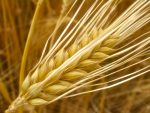 This cereal grain is a member of the grass family, Poaceae, that also includes rice, corn, and bamboo. Early evidence for barley indicates that it has been grown in Eurasia for about 10,000 years. It is an annual and grows over 36 inches tall so is considered a tall grass. The erect stout stems are hairless, often branched at the base, and bear a few linear to lanceolate leaves and terminal spikes up to 8″ long bearing cylindrical spiklets in a herringbone pattern. The spiklets bear the seeds in either two rows or six rows and have very long bristly awns that are reminiscent of a fox tail. Barley is used today for human consumption, animal fodder, and the production of beer and whiskey. The genus name, Hordeum, comes from an Indo-European root meaning bristly and refers to the the long prickly awns of the spiklets. The specific epithet, vulgare comes from the Latin word vulgaris meaning commonplace.
This cereal grain is a member of the grass family, Poaceae, that also includes rice, corn, and bamboo. Early evidence for barley indicates that it has been grown in Eurasia for about 10,000 years. It is an annual and grows over 36 inches tall so is considered a tall grass. The erect stout stems are hairless, often branched at the base, and bear a few linear to lanceolate leaves and terminal spikes up to 8″ long bearing cylindrical spiklets in a herringbone pattern. The spiklets bear the seeds in either two rows or six rows and have very long bristly awns that are reminiscent of a fox tail. Barley is used today for human consumption, animal fodder, and the production of beer and whiskey. The genus name, Hordeum, comes from an Indo-European root meaning bristly and refers to the the long prickly awns of the spiklets. The specific epithet, vulgare comes from the Latin word vulgaris meaning commonplace.
Type: Annual grass
Bloom: Bristly spikes up to 8″ long in summer
Size: 36′ H
Light:Full sun
Soil: Average, moderately moist, well-drained; somewhat drought tolerant
Hardiness: NA
Care: Low maintenance
Pests and Diseases: Bacterial blight, basal glume rot, barley stripe, barley yellow dwarf, common root rot, covered smut, downy mildew, ergot, eyespot, powdery mildew, FHB, smut, net blotch, leaf scald, aphids, army worms, mealy bugs, stink bugs, wire worms, thrips,
Propagation: Seed
Outstanding Selections: A very large number of cultivars exist that vary in many ways.